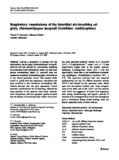Respiratory vasculatures of the intertidal air-breathing eel goby, Odontamblyopus lacepedii (Gobiidae: Amblyopinae)

URL ที่เชื่อมโยง
naosite.lb.nagasaki-u.ac.jpวันที่
2008Page views
225เมตาดาต้า
แสดงระเบียนรายการเต็มCited times in Scopus
Share
นามธรรม
Lacking a propensity to emerge over the mud surface, the eel goby, Odontamblyopus lacepedii, survives low tide periods by continuously breathing air in burrows filled with hypoxic water. As with most marine air-breathing fishes, O. lacepedii does not possess an accessory air-breathing organ, but holds air in the buccal-opercular cavity. The present study aimed to clarify how the respiratory vasculature has been modified in this facultative air-breathing fish. Results showed that the gills apparently lacked structural modifications for air breathing, whereas the inner epithelia of the opercula were richly vascularized. Comparison with two sympatric gobies revealed that the density of blood capillaries within 10?m from the inner opercular epithelial surface in O. lacepedii (14.5 ± 3.0 capillaries mm-1; mean ± s.d., n = 3) was significantly higher than in the aquatic non-air-breathing Acanthogobius hasta (0.0 ± 0.0) but significantly lower than in the amphibious air-breathing mudskipper, Periophthalmus modestus (59.1 ± 8.5). The opercular capillary bed was supplied predominantly by the 1st efferent branchial arteries (EBA1) and drained by the opercular veins, which open into the anterior cardinal vein. Deep invaginations at the distal end of the EBA1 and the junction with EBA2 are suggestive of blood flow regulatory sites during breath-holding and apnoeic periods. It remains to be investigated how blood flow through the gills is maintained during breath holding when the buccal–opercular cavity is filled with air.
การอ้างอิง
Gonzales, T. T., Masaya, K., & Ishimatsu, A. (2008). Respiratory vasculatures of the intertidal air-breathing eel goby, Odontamblyopus lacepedii (Gobiidae: Amblyopinae). Environmental Biology of Fishes , 82(4), 341-351. https://doi.org/10.1007/s10641-007-9295-5
เรื่อง
Taxonomic term
คอลเลกชัน
- AQD Journal Articles [1215]


